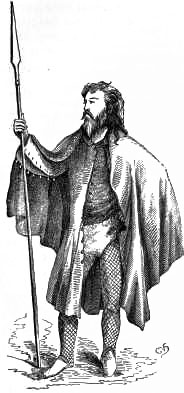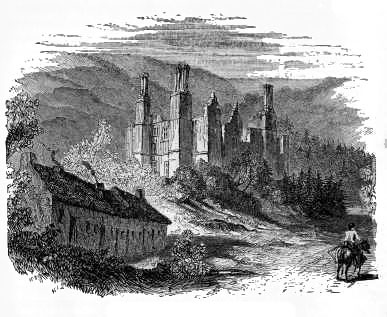Peasant Dress and Diet
The arms and military accoutrements of the period have already been mentioned incidentally, and are illustrated by the different costumes in our engravings, which Mr. Doyle has rendered with the minutest accuracy of detail. This subject, if treated at all, would require space which we cannot afford to give it. The Life Guards were embodied by Charles II., in 1681, in imitation of the French "Gardes des Corps." The Coldstream were embodied by General Monk, in 1660, at the town from whence they obtained their name.
From an account in the Hamilton MSS., published in the Ulster Archaeological Journal, it would appear that it was usual, or, at least, not uncommon, for young men of rank to go abroad for some time, attended by a tutor, to perfect themselves in continental languages. It need scarcely be said that travelling was equally tedious and expensive. A journey from Dublin to Cork occupied several days; postchaises are a comparatively modern invention; and Sir William Petty astonished the good people of Dublin, in the seventeenth century, by inventing some kind of carriage which could be drawn by horses. "With his description of the condition of the lower classes in Ireland at this period, I shall conclude this chapter. The accompanying figure represents the costume of the Irish peasant about the fifteenth century. The dress was found on the body of a male skeleton, in the year 1824, which was preserved so perfectly, that a coroner was called to hold an inquest on it. The remains were taken from a bog in the parish of Killery, co. Sligo. The cloak was composed of soft brown cloth; the coat of the same material, but of finer texture. The buttons are ingeniously formed of the cloth. The trowsers consists of two distinct parts, of different colours and textures; the upper part is thick, coarse, yellowish-brown cloth; the lower, a brown and yellow plaid.
It need scarcely be said that travelling was equally tedious and expensive. A journey from Dublin to Cork occupied several days; postchaises are a comparatively modern invention; and Sir William Petty astonished the good people of Dublin, in the seventeenth century, by inventing some kind of carriage which could be drawn by horses. "With his description of the condition of the lower classes in Ireland at this period, I shall conclude this chapter. The accompanying figure represents the costume of the Irish peasant about the fifteenth century. The dress was found on the body of a male skeleton, in the year 1824, which was preserved so perfectly, that a coroner was called to hold an inquest on it. The remains were taken from a bog in the parish of Killery, co. Sligo. The cloak was composed of soft brown cloth; the coat of the same material, but of finer texture. The buttons are ingeniously formed of the cloth. The trowsers consists of two distinct parts, of different colours and textures; the upper part is thick, coarse, yellowish-brown cloth; the lower, a brown and yellow plaid.
"The diet of these people is milk, sweet and sour, thick and thin; but tobacco, taken in short pipes seldom burned, seems the pleasure of their lives. Their food is bread in cakes, whereof a penny serves a week for each; potatoes from August till May; muscles, cockles, and oysters, near the sea; eggs and butter, made very rancid by keeping in bogs. As for flesh they seldom eat it. Their fuel is turf in most places." The potatoe, which has brought so many national calamities on the country, had been then some years in the country, but its use was not yet as general as it has become since, as we find from the mention of "bread in cakes" being an edible during a considerable part of the year.

Castlecaulfield, County Tyrone
